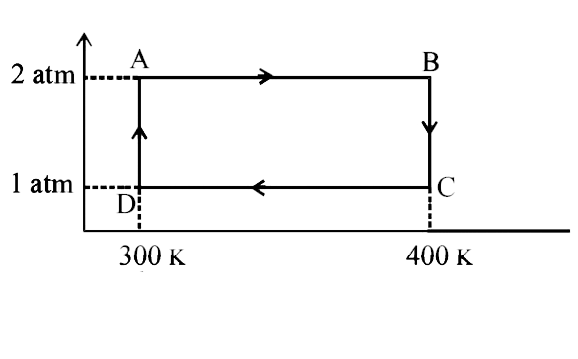A rocket with a lift-off mass 3.5×104kg is blasted upwards with an initial acceleration of 10m/s2. Then the initial thrust of the blast is
1.75×105N
3.5×105N
7×105N
14×105N
The correct Answer is:C
To find the initial thrust of the rocket, we can use Newton's second law of motion. The thrust must overcome both the weight of the rocket and provide the necessary force for the upward acceleration.
1. Identify the given values:
- Mass of the rocket, m=3.5×104kg
- Acceleration of the rocket, a=10m/s2
- Acceleration due to gravity, g=10m/s2
2. Calculate the weight of the rocket:
The weight W of the rocket can be calculated using the formula:
W=m⋅g
Substituting the values:
W=3.5×104kg×10m/s2=3.5×105N
3. Calculate the total force required for the upward motion:
The total force F required to lift the rocket can be calculated using the formula:
F=W+m⋅a
Here, m⋅a is the force required to provide the upward acceleration. Thus:
F=W+m⋅a=3.5×105N+(3.5×104kg×10m/s2)
=3.5×105N+3.5×105N=7.0×105N
4. Conclusion:
The initial thrust of the rocket is:
Thrust=7.0×105N
Final Answer:
The initial thrust of the blast is 7.0×105N.
---
- Mass of the rocket, m=3.5×104kg
- Acceleration of the rocket, a=10m/s2
- Acceleration due to gravity, g=10m/s2
The weight W of the rocket can be calculated using the formula:
W=m⋅g
Substituting the values:
W=3.5×104kg×10m/s2=3.5×105N
The total force F required to lift the rocket can be calculated using the formula:
F=W+m⋅a
Here, m⋅a is the force required to provide the upward acceleration. Thus:
F=W+m⋅a=3.5×105N+(3.5×104kg×10m/s2)
=3.5×105N+3.5×105N=7.0×105N
The initial thrust of the rocket is:
Thrust=7.0×105N
The initial thrust of the blast is 7.0×105N.
Topper's Solved these Questions
- BOOK - DC PANDEY ENGLISHCHAPTER - LAWS OF MOTIONEXERCISE - Match the columns7videos
LAWS OF MOTION
- BOOK - DC PANDEY ENGLISHCHAPTER - KINEMATICS 1EXERCISE - INTEGER_TYPE15videos
KINEMATICS 1
- BOOK - DC PANDEY ENGLISHCHAPTER - LAWS OF THERMODYNAMICSEXERCISE - Level 2 Subjective18videos
LAWS OF THERMODYNAMICS
Similar Questions
Match the following columns.
Column IColumn II(A) Force of friction(p) Oppose motion(B) Normal reaction on a block kept on horizontal ground(q) Oppose relative motion(r) Is always mg(s) May be equal to mg(t) None02:39View SolutionA stone is dropped from a certain height which can reach the ground in 5s. It is stopped after 3s of its fall and then it is again released. The total time taken by the stone to reach the ground will be .
02:11View SolutionTwo moles of helium gas undergo a cyclic process as shown in Fig. Assuming the gas to be ideal, calculate the following quantities in this process
(a) The net change in the heat energy
(b) The net work done
(c) The net change in internal energy
 03:03View Solution
03:03View SolutionA rocket with a lift-off mass 3.5xx10^4 kg is blasted upwards with an initial acceleration of 10m//s^2 . Then the initial thrust of the blast is
02:04View SolutionA rocket with a lift off mass 20000 kg is blasted upwards with a net intial acceleration of 5 ms^(-2) Calculate the initial thrust (force) of the blast.
02:56View SolutionA rocket with a lift mass of 10,000 kg is blasted upwards with an acceleration of 10ms^(-2) . Calculate the initial thrust of the blast
02:40View SolutionA rocket with a lift-off mass 2xx10^(4)kg is blasted upwards with an initial acceleration of 5ms^(-2) . The initial thrust of the blast is ("Take g"=10ms^(-2))
03:05View Solution20,000 kg उत्थापन सह्न्ति के किमी रॉकेट में 5 m s−2 के आरंभिक त्वरण के साथ ऊपर की और स्फोट किया जाता है । स्फोट का आरंभिक प्रणोद (बल ) परिकलित कीजिय ।
01:45View SolutionA rocket with a lift -off mass 20 , 000 kg is blasted upwards with an initial acceleration of 5.0"ms"^(-2) . Calculate the initial thrust (force) of the blast .
03:08View SolutionA rocket with a lift - off mass 20,000 kg is blasted upwards with an initial acceleration of 50 ms^(-2) . Calculate the initial thrust (Force ) of the blast .
01:53View SolutionA rocket with a lift-off mass 20,000 kg is blasted upwards with an initial acceleration of 5.0 m s^(-2) . Calculate the initial thrust (force) of the blast.
03:49View SolutionA rocket with a lift-off mass 20,000 kg is blasted upwards with an initial acceleration of 5.0ms−2 . Calculate the initial thrust (force) of the blast.
01:57View SolutionA rocket with a lift off mass 20000 kg is blasted upwards with a net initial acceleration of 5ms−2 Calculate the initial thrust (force) of the blast.
03:35View SolutionA rocket with a lift-off mass 20,000 kg is blasted upwards with an initial acceleration of 5.0 ms2 . Calculate the initial thrust (force) of the blast.
01:30View SolutionA rocket with a lift-off mass 2×104kg is blasted upwards with an initial acceleration of 5ms−2. The initial thrust of the blast is (Take g=10ms−2)
01:46View Solution

